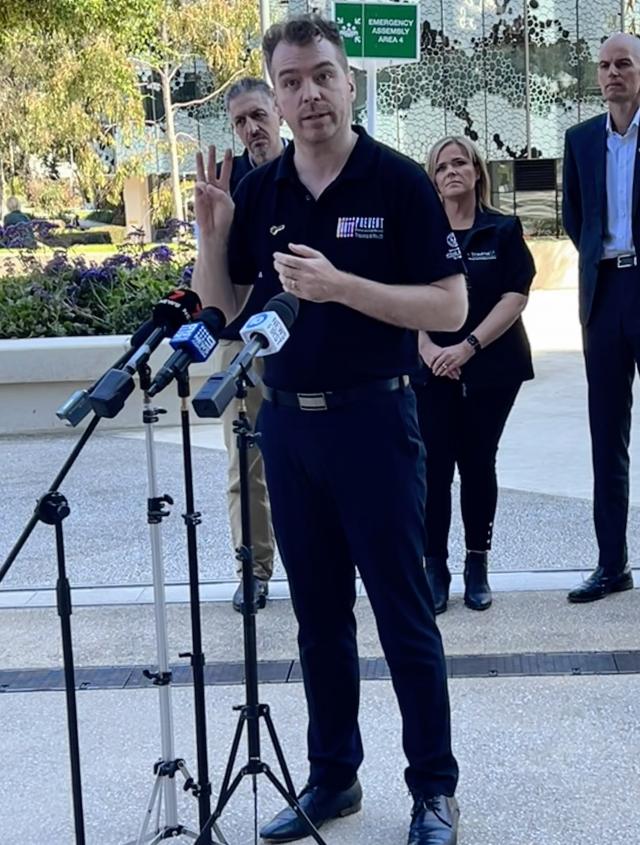
Charlotte Varcoe
A THREE second decision on the road outside of Mount Gambier/Berrin changed the life of former resident Jack Annear’s life forever.
Mr Annear was travelling on Nelson Road on November 17, 2007 just on the outskirts of town where he was involved in a fatal car collision with five other people.
Three members of the collision passed away while the survivors had life-altering injuries.
Speaking with The Border Watch, Mr Annear recalled the incident and labelled it as a “normal Friday night”.
“We were turning right to head back towards Mount Gambier where we were struck on the driver’s side,” Mr Annear said.
“Both drivers did everything right, no drugs, alcohol or speeding were involved, the police believe it was just one wrong decision by our driver.
“From that impact three young men lost their lives and three – including myself – were injured and had their lives irrevocably changed.”
Suffering from major injuries, Mr Anear had a bleed on the brain, a break in his neck, a ruptured blood vessel to the heart, liver, a severed urethra, fractured pelvis, fractured femur which formed a spear into his hamstring resulting in a clot which was surgically removed and an open fracture on his tibia and fibula in his right leg.
“I also have retrograde amnesia from the whole event and even days leading up to it,” he said.
“I was in a coma at the Royal Adelaide Hospital where I was taken to by the Royal Flying Doctor Service and I needed a total of 17 litres of blood transfused just to keep me alive.”
Mr Annear said he was also resuscitated twice before being stabilized about three or four days after the collision.
“My parents told me the doctors said I was going to be completely brain dead, a quadriplegic and all of the doomsday scenarios but in one of my cohesive moments was to recall dad’s birthday which was a really good sign for a lack of brain injury,” he said.
It was not until waking from his coma did Mr Annear learn about the incident.
“The start of my recovery was asking about what I was doing in hospital, why I hurt everywhere and my mum gently letting me know what had happened,” he said.
“I remember crying, but that was a watershed moment to not wanting to be in the hospital getting back home to my friends and comfort zone in Mount Gambier to process what had happened to me.”
He said the doctors would let him leave the hospital and return home should he be able to sit above 30-degrees and sit out of bed for an hour before learning to walk again.
“They were happy for me to continue my recovery at home after that which gave me a bit of a road map for rehabilitation,” Mr Annear said.
“Due to my coma I lost 30 kilograms and started with zero muscle tone so I had to start from the very beginning.
“During rehabilitation I was rebuilding my muscles from scratch and sometime over the Christmas and New Years period I was successful in walking again and after having done that they said I could continue my recovery at home.”
Eventually, Mr Annear underwent surgery to reconnect his urethra and bladder and he was also able to get his licence back in April of 2008.
“That was amazing for my mental recovery because I wasn’t trapped at home with some very dark thoughts anymore. My retrograde amnesia meant I was not afraid to get behind the wheel again,” he said.
“I also started adjusting to my new normal which meant no more hockey or tennis because of the injuries to my legs as it was really painful for me to do anything for a significant amount of time.
“I could get back to surfing but needed a modified wetsuit and touch football is possible but the plate in my leg means my bones flex when changing direction on my right leg and is agonizing.”
Mr Annear was also diagnosed with trauma induced epilepsy since his accident and recovery but despite this, he now remains committed to sharing his experience in road trauma in the hopes it prevents it happening to others.
“Three seconds can change people’s lives and if something does not quite feel right, people should take those extra three seconds to make a better decision to ensure they are safe on the road,” he said.
“We need to empower young people to make those better decisions and hopefully they will never end up in that situation that we found ourselves in.”
Mr Annear said since completing university and beginning his job in Adelaide he had been fortunate enough to be put through many defensive driver trainings and workshops, realizing the problems with our driver education program.
“There is something inherently wrong with our training program for young drivers if reverse parallel is still the most stressful situation in the test – there is so much more danger especially in the high speed and regional areas around South Australia,” he said.
“Young drivers need to know what it feels like when the automatic braking system or vehicle stability control is kicking in as an example to make sure they do not overcorrect and potentially put themselves in a worse situation.
“That is the type of thing I would love to see put into driving training programs, especially for young people because I feel like if they do not understand the danger they will not respect the road.”
Mr Annear now shares his story with schools and organisation around the state.








